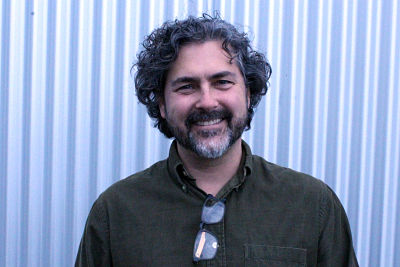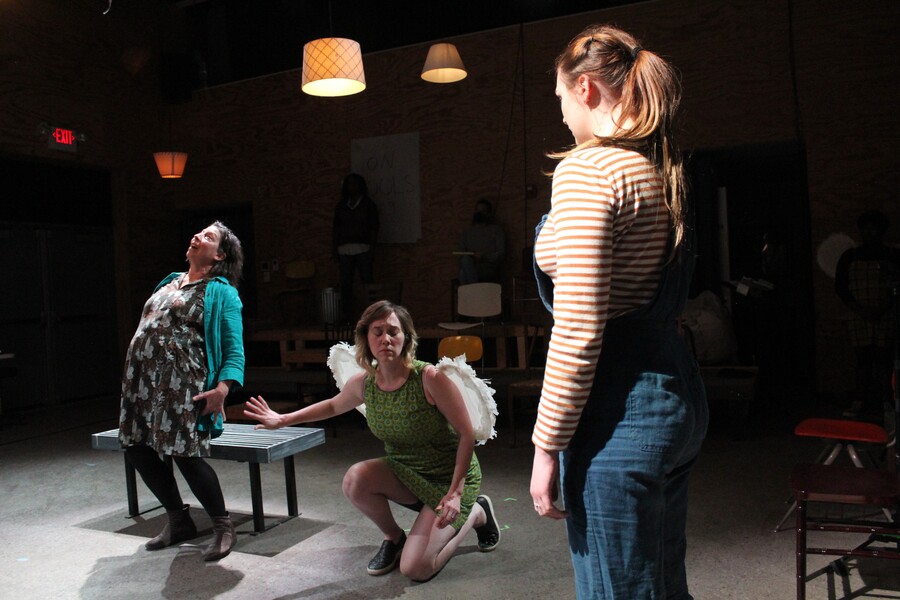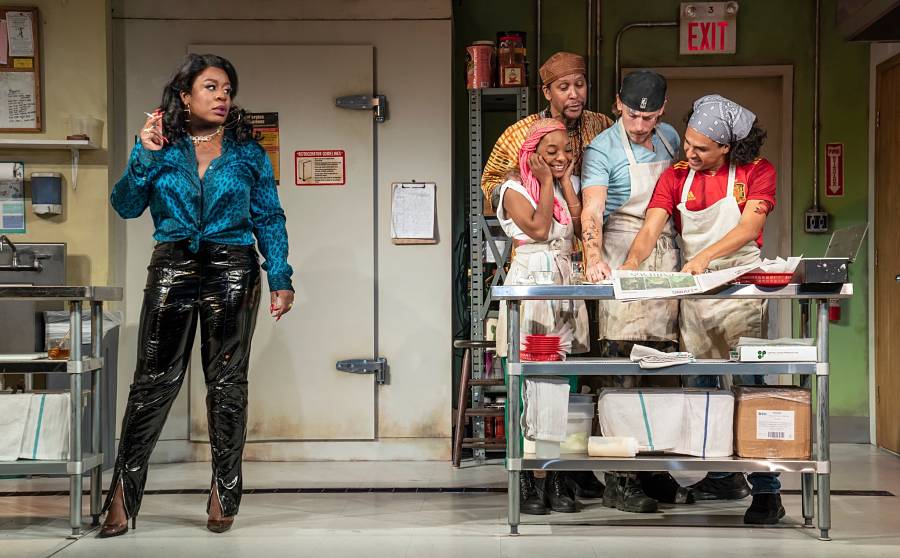Over the course of the pandemic closures, the Cherry Arts, home to the Cherry Artists’ Collective in Ithaca, N.Y., did what many theatres across the country did to continue making their art: They split their season between outdoor and streamed shows. Earlier this year, the company staged and streamed Alejandro Ricaño’s Hotel Good Luck (translated by Jacqueline Bixler). This wasn’t an edited-down rendition of the play, recorded in front of a live audience, but a production patrons could only live-stream. According to Cherry artistic director Samuel Buggeln (he/him), doing it live, with a specific date and time to be watched, made the collective realize that producing their art this way felt true to their work as theatremakers. By keeping it live, they found they were able to capture the feeling of urgency and immediacy that accompanies a performance happening now.
“We thought that was an important limitation, to make it still feel like we were theatremakers,” said Buggeln. “There were even, at the time, people saying, ‘You all are crazy, it’s so much harder’—which it is. You have to work really hard to find ways to make the audience feel the liveness of the event.”

The audience responded. Buggeln, in an interview last week, noted that their first two streaming shows sold surprisingly well. He offered the caveat that, because they’re a smaller theatre (with expenses sitting comfortably under $150,000 in the years leading up to the pandemic), they of course weren’t expecting to sell thousands of tickets in the first place. But the point stands: Their audience showed up in numbers that allowed them to sell what they had budgeted for.
This audience wasn’t just local devotees, either; viewers were tuning into their productions from outside of Ithaca, which can perhaps be attributed to the Cherry’s track record and interest in producing international work. This proved to Buggeln and the company’s collective that not only is there a real audience for their live-streamed work, but that this work still has a place in their season as they have begun to welcome audiences back in person to their intimate, adjustable Cherry Artspace.
Earlier this month, the Cherry presented the world premiere of And What Happens If I Don’t, by Serbian playwright (and repeated Cherry collaborator) Iva Brdar, in a translation by Ana Brdar, as a hybrid production. They sold a two-week run in their in-person Artspace, with social distancing still in place for seating, along with a handful of simulcast productions for digital audiences.
“Let’s embark on this experiment next season,” Buggeln recalled thinking, “and see what happens if we do a live show and we do it with hybrid streaming as well. That audience outside of our area and/or folks who don’t want to come into the theatre for whatever reason—will enough of those folks want a streaming ticket to make it worth putting together?”
Though Buggeln acknowledged that the show sold a bit below their historical average—which the company anticipated, not least because of the rising concern around yet another COVID variant—he said that streaming tickets wound up accounting for 28 percent of their box office revenue and 33 percent of the overall number of tickets sold. Streaming passes, he noted, were a bit cheaper than in-person tickets, and the company only streamed five of the eight overall performances.
Buggeln noted that there many patrons expressed gratitude for this digital option given the news of the spreading Omicron variant. Even some locals were still more comfortable viewing from home than even sitting masked and socially distanced in a reduced-capacity theatre.
“We were very surprised at first,” Buggeln said after seeing some of the names on the list of streaming ticket purchases. “It really made us go, ‘Holy cow, this is still filling a real need.’ That said, when everybody’s totally comfortable coming into a theatre in person again, how much business will streaming do is still a question. But I think it’s not going to be zero, because people are really used to it.”

Indeed, the online doors that COVID forced open for theatres may never truly close again, nor will the demand for it ever again reach zero. Whether or how organizations will continue to experiment with the form, or incorporate a virtual audience as they welcome back in-person audiences, is the oft-asked question. (Other questions, including about the return on investment for theatre’s digital efforts in general, receive mixed answers.) While many regional theatres are now filming select performances with live audiences, and offering them to home audiences for online viewing after the fact within a timed window, a la an Amazon rental, Broadway theatres are likely to continue to bring theatre to the masses by editing together multiple performances into seamless productions a la Disney+’s Hamilton, Netflix’s Diana: The Musical, or Apple TV+’s Come From Away.
But New York City’s Second Stage Theater, one of four nonprofits programming on Broadway, was looking to do something different and provide more access in the bargain. So from Jan. 4 to 16, 2022, Second Stage will be partnering with production company Assemble Stream to simulcast the final two weeks of the Uzo Aduba-starring production of Lynn Nottage’s Clyde’s. While Second Stage executive director Khady Kamara (she/her) said the theatre’s priority is still the in-person audience, there’s another audience outside of those who can attend in person that ought to be considered.
Added Assemble Stream’s Katie McKenna (she/her), “We really just want to add to the live experience. We recognize the value and incredible experience of going to live theatre in person. So as much as we can offer that as an additive to theatres by opening up this virtual access point—that is really what our goal is.”
McKenna said the setup will be similar to that of live television, with five to seven cameras capturing multiple angles. The cameras will be tucked out of sight of the in-person audience and operated remotely. When deciding how to approach these sorts of live-stream productions, McKenna said it’s important to listen and adapt to the technical and financial needs and limitations of their partners in order to build the right strategy. Audience members, McKenna said, are doing their logistical planning as well: She said she’s heard from folks who’ve said they’ll use the unique opportunity of live theatre to invite friends over for a dinner and a show, creating a sense of event by casting a live Broadway show directly to their TV.
Both McKenna and Buggeln echoed similar thoughts: that there’s something special about having that appointment to view something live—an aspect that can get lost in the finely tuned, recorded, and edited-in-post productions.
“High-end filmed theatre has a feeling now for people,” Buggeln said. “That’s the feeling of the live stream of the Metropolitan Opera or the PBS films of Into the Woods or of Broadway shows. We know what that feels like, and we can’t do that.”
It’s a simple matter of economics, as a small company like Buggeln’s will never have the resources to accomplish what made-for-streaming can provide. Doing it live is an idea that he’s found to be scalable. The key, Buggeln said, is figuring out how to marry available resources with telling the story of the play.
“As a theatre director who is really into high production value, it costs me something to be like, ‘This is going to be rougher and more mistakes are going to happen because we’re doing it live.’”
“If you have a limited number of things you can do, you have to think, ‘Okay, what is this play exactly?’” said Buggeln. “How can we meet it on its own terms with our limited tool set? It sort of forces you to be more creative and more specific. That’s actually not different than all of our productions—we do that in terms of our in-person stagings as well.”
Brdar’s And What Happens If I Don’t, which is directed by collective member Susannah Berryman, wound up working well for this kind of experimentation. The play is written as a series of monologues that can be performed by one or two actors. The Cherry saw this as an ensemble piece, breaking up the series of 13 monologues (with the playwright’s permission) to turn them into conversations, which Berryman said allowed this piece to grow from one person’s experience to something more universal.
Leaning into that, the production was staged in the round, and the house lights never dim, with Buggeln saying they were going for a feeling of a sort of community revival house where a group of people have gathered in a room to experience something together. For the production, Berryman was able to focus solely on the in-person experience, not worrying about camera angles or anything on the streaming side. Buggeln then worked with the live-stream design team of Karen Rodriguez (she/her) and Greg Levins (he/him) to make choices that both kept the production on budget and avoided detracting from or interfering with the onstage in-person experience.
This was Rodriguez’s first time working with the Cherry, though she was familiar with their past work and excited for the chance; meanwhile this was Levins’s first time working on a theatre production. After the two filmmakers were brought on—after much of the staging had been worked out, a regrettably short timeline for both of them—Rodriguez was charged with finding the flow of the play, prioritizing what shots they’d need, and utilizing OBS Studio, a popular software used for live streaming on website like Twitch and one used by the Cherry for previous streams.
“The first part was really just figuring out the tech and then trying to understand the staging,” said Rodriguez. “It was a sort of negotiation, just trying to make sure that the actors are visible—that it’s the best position for that particular moment. I tried to just kind of hang back from their process at first so that we weren’t changing things or asking for changes before I really understood what the play really was and how it was going to function.”
They decided to use webcams, stationing four around the room in “audience member positions” and the other three in unique angles (like an overhead shot) that could provide additional value for those watching at home. During the show, Rodriguez was charged with switching the cameras live while Levins was offsite monitoring the stream, able to alert Rodriquez to any issues that might not be noticed in person. Rodriguez acknowledged that there have been a couple of slip-ups during the streams, but nothing an audience would have noticed, and certainly nothing that would take away from the advantage of being able to provide this art live.

“There’s a lot of excitement and energy, knowing that what you’re seeing is an actual live performance, that something could go wrong,” said Rodriguez. “It’s definitely exciting to know that it’s live and there’s sort of a rawness to the image quality that we have that hopefully goes hand in glove with that feeling.”
That said, there’s still the lingering desire to tidy up some of that rawness—to take things into post-production and buff off some of that roughness. This was another learning experience for the Cherry, and for theatre in general. It’s a new process, so it’s understandable that all involved left feeling like there were tweaks they would make if they had another chance. For one, Levins, who said he found the process challenging as well as enjoyable, said he wished there had been time to incorporate the acting and cameras more fully during the process.
“Planning, planning, and planning some more,” said Second Stage’s Khady Kamara of the key to success for the upcoming Clyde’s simulcast. “Just making sure that we give ourselves adequate time to work through the technical aspect of it while putting at the forefront the art that we’re putting on our stages. It’s a wise business move to give yourself plenty of time to ensure that there is an ability to plan ahead.”
Rodriguez’s lingering thought: She would like to try more professional cameras rather than webcams, which offer wide angles but react poorly to lighting changes—though she acknowledged that would mean investing in a more expensive interface that would work with the pricier equipment. Buggeln knows these feelings well. Had they wanted to (and budgeted for it), they could have recorded, edited, mixed, and corrected sound and color balance. But the value of the live experience had to take the front seat.
“As a theatre director who is really into high production value, it costs me something to be like, ‘This is going to be rougher and more mistakes are going to happen because we’re doing it live,’” Buggeln admitted. “But still it feels worth it just for the liveness. It’s a big question we wrestle with a lot. Like, mistakes will happen. It’s not going to be as good in some ways, but it’s going to be a better experience—a more exciting theatrical experience that’s not going to be as slick.”
As for the future, Buggeln will direct the Cherry’s next production, Freek Mariën’s The Wetsuitman (translated by David McKay), which the Cherry will once again offer as a hybrid in-person and live-streamed production in March 2022. Already Buggeln said he’s tossing around the possibility of actors carrying cameras or passing a camera around as a way to incorporate the live streaming into the staging of the play. As Buggeln noted, the company’s emphasis on experimental work and international fare naturally lends itself to continuing and expanding this kind of digital experimentation.
“We dig it and we’re going to keep doing that,” said Buggeln. “Hopefully that will keep not only provoking our questions of, how do we best stage this cuckoo international play in physical space for an in-person audience, but also how does streaming layer in? I really look forward to that whole extra dimension being part of the conversation going forward.”
Jerald Raymond Pierce (he/him) is associate editor of American Theatre. jpierce@tcg.org


